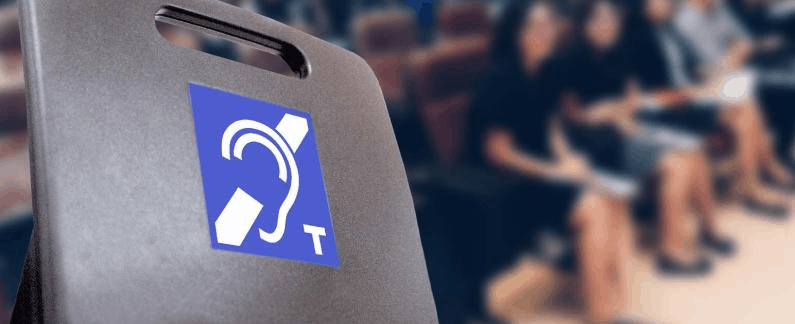
Assistive listening devices (ALDs) are devices used with or without hearing aids, bone-anchored implants, and cochlear implants to make sounds more accessible to people with varying degrees of hearing impairment.
Hearing aids, bone-anchored implants, and cochlear implants are specifically designed to enhance conversational speech and work best in one-on-one situations and in relatively quiet environments. There are, however, some circumstances where additional listening support is useful and necessary. Some of these situations include listening in the presence of background noise, at a distance, or in special circumstances such as listening to a television, while using a telephone, or at a lecture in a large hall.
Many people with hearing loss depend on or can benefit from some kind of ALD to help them develop or maintain a comfortable level of independence in their daily lives. From infra-red TV headsets to closed-captions (CC) while watching TV or the phone to amplified telephones and stethoscopes, there are an array of ALDs to help people with hearing loss remain connected to their world.
FM Systems
Frequency modulated (FM) systems are a type of ALD that makes it easier for those with hearing loss to hear in complex listening environments and are widely used in educational settings. FM systems are micro-radio transmission systems that maximize the speaker’s voice. In a classroom setting, the teacher speaks into a small, portable microphone (usually clipped onto his/her collar or lapel) and the sound is delivered wirelessly to the student’s hearing device using FM signals. To connect with the FM system, it may require a neck loop or an ear-level receiver, sometimes referred to as a hearing aid boot. With the direct streaming to the listener’s ears, FM systems limit background noise, distance from the speaker, and effects of the acoustics of the environment, like reverberation/echoing. FM systems are also useful for adults in many listening situations such as noisy restaurants, meetings, lectures, and in places of worship.
Sound Field Systems
Another commonly used listening system designed for classrooms is a sound-field system. With this system, the teacher wears a small, wireless microphone and the sound signal is sent to strategically placed speakers located across the classroom to enhance the speech signal to all pupils. Sound-field systems are not only beneficial for students with hearing loss, but many studies have shown that all students in the classroom benefit when sound field systems are used to improve classroom acoustics.
T-Coils and Loop Systems
Telecoils, sometimes referred to as T-coils, and loop systems are another type of ALD and have been available in hearing aids for more than 50 years. A telecoil is a small copper coil located inside the housing of many hearing devices and serves as a receiver or antenna. In a “looped” area, such as a living room or auditorium, the T-coil picks up the electromagnetic signal and streams it directly into the hearing device. The signal can be from a microphone, PA system, or a telephone. Induction looped systems are found in some theaters, museums, airports, places of worship, and even some taxi cabs. To know if a venue is looped, look for the blue universal loop system sign.
Alerting Devices
Beyond the most common ALDs mentioned above that help primarily with communication, there are also alerting devices (ADs) designed to help those with hearing loss stay safe and connected during day-to-day and emergency situations. These ADs can use visual signals, such as a flashing or strobing light, vibrotactile indicators, for a vibration component, or alternative auditory signals, such as a louder alarm or one of a lower pitch. For example, there are alarm clocks with strobe lights, or perhaps a vibrating pillow inserts—to help wake people who cannot hear the typical alarm. Additionally, there are similar ADs for fire and smoke alarm systems, carbon monoxide alarms, door bells, and baby monitors.
Bluetooth
With the introduction of Bluetooth wireless connectivity, there have been many advancements in standard features of hearing aids, which act as a more complete and often seamless listening system. With Bluetooth connections to your smartphone or tablet, you can stream music, videos, podcasts, and phone calls directly to your hearing devices. There are smartphone applications that can be used as a remote control for some hearing aids, tinnitus maskers, and portable microphones.
These products (ALDs and ADs) are commercially available and are highly recommended. If you are interested in learning more about assistive listening and alerting devices to get the best and most useful products to enhance your daily life and listening experience, speak with your audiologist or click here to “Find an Audiologist” and set up an appointment.